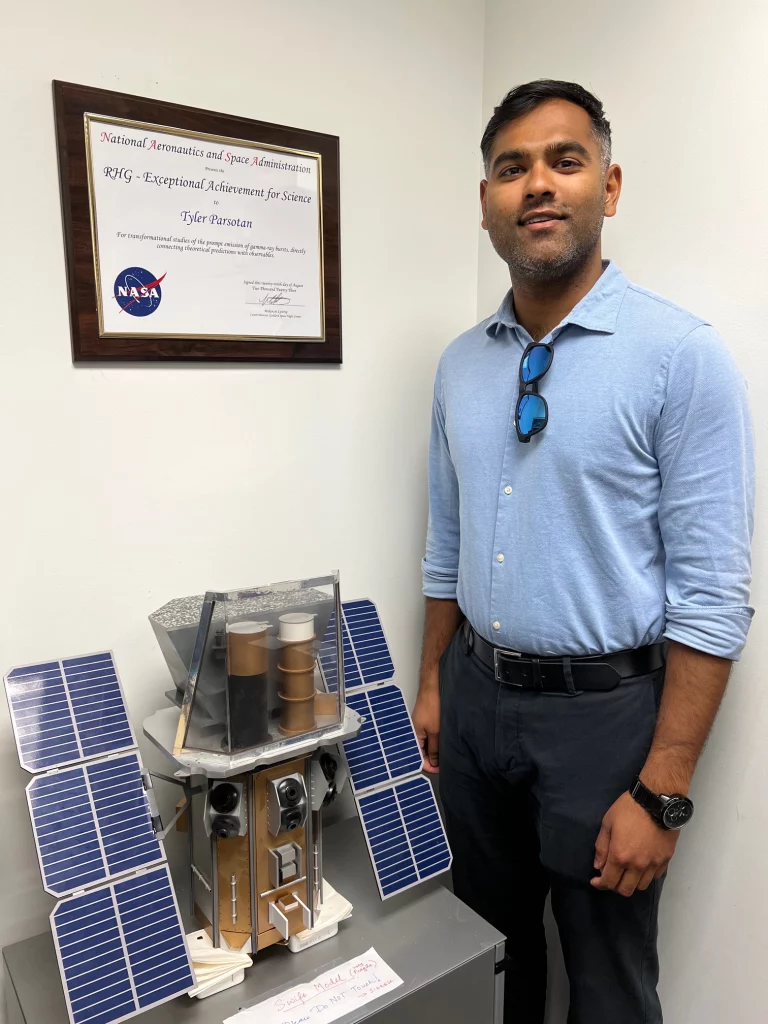1. Introduction
In the vast realm of scientific exploration, many researchers are dedicated to unraveling one of the universe’s most enigmatic phenomena—transient events. Tyler Parsotan is a distinguished scientist in this field, playing a significant role in NASA’s Swift mission. The Swift mission is a space observatory project designed to capture and study gamma-ray bursts (GRBs) and other transient astronomical phenomena. This article will delve into Tyler Parsotan’s scientific background, the workings of the Swift mission, and how Parsotan advances our understanding of the transient universe through his work with Swift.
2. Tyler Parsotan’s Scientific Background
Tyler Parsotan, an astrophysicist at NASA’s Goddard Space Flight Center, has a rich background in the study of various astronomical phenomena, with a particular focus on transient events. Parsotan’s academic credentials are extensive, including advanced degrees in physics and astronomy and research completed at several prestigious institutions. His research interests encompass gamma-ray bursts (GRBs), X-ray flares, supernovae, and other high-energy astrophysical events.
Before joining NASA Goddard, Parsotan conducted research at several leading international institutions. His career includes roles in numerous international collaborative projects, involving both theoretical research and practical data analysis and experimental design. Due to his outstanding contributions to these fields, Parsotan is considered one of the leading experts in transient universe research.
3. Overview of the NASA Swift Mission
NASA’s Swift mission is a multi-wavelength astronomical satellite project aimed at detecting and studying gamma-ray bursts (GRBs) and other transient cosmic phenomena. The Swift mission, developed jointly by NASA, the European Space Agency (ESA), and the Italian Space Agency (ASI), was successfully launched on November 20, 2004, and has been providing invaluable data to the scientific community ever since.
The core of the Swift mission comprises three primary instruments:
- Burst Alert Telescope (BAT): Responsible for detecting the sources of gamma-ray bursts and providing preliminary localization information.
- X-ray Telescope (XRT): Quickly follows up on the detection of gamma-ray bursts to conduct detailed observations in the X-ray band.
- Ultraviolet/Optical Telescope (UVOT): Observes the optical and ultraviolet radiation associated with gamma-ray bursts and their afterglows, providing scientists with additional data in these wavelengths.
Swift’s design allows it to respond rapidly to transient events in the universe. This quick-response capability is crucial for capturing and analyzing these brief but highly significant astronomical phenomena.

4. Tyler Parsotan’s Role in the Swift Mission
Tyler Parsotan’s role in the Swift mission primarily focuses on data analysis and scientific research. His work spans from the initial detection of gamma-ray bursts to detailed follow-up analysis. Within the Swift mission, Parsotan is involved in several key areas:
- Data Analysis: Parsotan is responsible for analyzing data from Swift’s various observational instruments, particularly the gamma-ray burst data. He employs complex algorithms and data processing techniques to extract meaningful information from raw data, aiding scientists in understanding these transient events.
- Research Findings: Through in-depth analysis of Swift data, Parsotan has contributed to many important scientific discoveries. For instance, he has been involved in research on the origins and evolution of certain gamma-ray bursts, significantly enhancing our understanding of these extreme cosmic phenomena.
- Collaboration and Communication: Parsotan maintains close collaboration with astronomers and research institutions worldwide. They share data and research findings to advance scientific progress. Additionally, Parsotan participates in relevant scientific conferences and workshops, sharing the latest developments and results from the Swift mission.
5. The Significance of Transient Universe Research
Research on the transient universe is vital for understanding the evolution of the cosmos and extreme astrophysical processes. Gamma-ray bursts and other transient events are among the most energetic releases of radiation in the universe, providing crucial information about black hole formation, stellar explosions, and the early evolution of the universe.
- Gamma-Ray Bursts: Gamma-ray bursts are among the most intense electromagnetic radiation events, with energy releases surpassing the total energy of all stars in the observable universe. Studying these events helps us understand their origins, physical mechanisms, and their impact on their surrounding environment.
- Supernovae: Supernovae are massive explosions in the life cycle of stars, releasing large amounts of heavy elements that contribute to the formation of new galaxies and planets. Research on supernovae provides insights into stellar evolution and the distribution of heavy elements.
- Other Transient Phenomena: In addition to gamma-ray bursts and supernovae, the Swift mission also studies other transient phenomena such as X-ray flares and gravitational wave events. These phenomena offer information about extreme physical conditions in the universe, helping us to better understand the fundamental structure and evolution of the cosmos.
6. Tyler Parsotan’s Contributions and Future Outlook
Tyler Parsotan’s contributions to the Swift mission not only enhance our understanding of the transient universe but also drive further scientific advancements. His research provides valuable data and insights for astronomers, addressing many long-standing scientific questions.
Looking ahead, Tyler Parsotan and his team plan to continue exploring Swift mission data to uncover more mysteries. Their work will involve a broader range of transient phenomena and aims to develop new observational techniques and data analysis methods to improve our detection capabilities and scientific understanding.
Moreover, Swift mission data will be integrated with data from other astronomical projects to create a more comprehensive view of the universe. This cross-project data fusion will offer scientists more information and clues, helping them to better understand various cosmic phenomena.
7. Conclusion
Tyler Parsotan’s work with the NASA Swift mission exemplifies the significant contributions of modern astronomers in exploring the universe’s transient phenomena. Through detailed research on gamma-ray bursts and other transient events, Parsotan and his team have not only revealed the mysteries of extreme physical processes in the universe but also advanced the field of astronomy. Their efforts deepen our understanding of the cosmos and lay a solid foundation for future scientific exploration. With ongoing technological advancements and research progress, we can expect continued revelations about the universe’s transient nature.


















































Discussion about this post